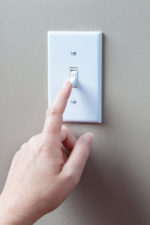Mortgage Rate Fundamentals
When it comes to buying a home, one of the biggest factors affecting when you make your move and what price you can afford is the market’s current mortgage rates.
Unfortunately, these are constantly fluctuating, making it difficult to decide on the right timing, and which one your lender offers is largely out of your control. However, by learning more about the basics of mortgage rates and exploring smart strategies, you can make more informed decisions that help you land the home of your dreams.

Understanding mortgage rates
Simply put, a mortgage rate is the percentage of interest a lender charges on the money borrowed to purchase a home. This is reflected in your monthly payment, which is goes partly toward your principal, or the loan amount, and the interest accrued. The current average mortgage rate is influenced by a number of factors, including the overall state of the economy, the Federal Reserve’s monetary policy, and the supply and demand for housing, and what rate you’re offered may be further influenced by individual factors such as how much you’re borrowing and your credit score.
In addition, the type of mortgage rate you seek can influence your number. You can generally choose between either a fixed rate, meaning it won’t change over the entire life of your loan, and an adjustable rate that may adjust on a regular basis depending on the market. The former offers stability but may mean a higher rate, while the latter may give you a lower rate to start but can mean being hit with a bigger one down the road. (For more about these two options, check out this blog.)
How they impact your homebuying power
Naturally, the current mortgage rates will affect how much money you can afford to borrow. As they rise, so does your potential monthly payment, in turn decreasing your buying power; the same is true in the opposite direction. Even just a small change in the mortgage rates can be significant. For example, if you can afford a monthly mortgage payment of $2,000, a 1 percent decrease in interest rate could allow you to spend upwards of $30,000 on a home without increasing that payment. Just keep in mind that the reverse is true as well, which is why the lower rate you can get, the better.
Tips for getting the best rate
If you are concerned about the current mortgage rates are two high or may increase before you can close, there are a few things you can do to manage the situation.

Shop around for the best rate
As with making any major purchase, you’ll want to compare offers from multiple lenders to find the most favorable terms for your loan. This involves looking not just at interest rates but also at closing costs and other associated fees. By seeing all that’s available, you can better ensure that you find the best deal for you and potentially save money on your mortgage. It’s recommended to obtain quotes from at least three lenders to get a comprehensive understanding of the available options.
Get preapproved for a mortgage
This is like receiving a stamp of approval from a lender, indicating that they’re likely to grant you a loan to purchase a home. The process involves the lender assessing your financial situation, including your income, credit score, debt-to-income ratio, and assets, to determine your ability to repay the loan. If your finances meet their criteria, you’ll receive a preapproval letter, which can give you a more clear idea of what your budget is so you can target homes that won’t stretch your affordability too far.
Lock in your mortgage rate
With this strategy, you’re agreeing to the interest rate that the lender is offering at that particular time. This helps protect you from potential rate increases that may occur before you close on your home. By locking in, you can have greater certainty about your monthly mortgage payments and the overall cost of your loan. However, it’s important to note that locking in may come with a fee and that rates can sometimes decrease after you’ve locked in.
Consider an adjustable-rate mortgage (ARM)
As touched on above, this is a type of mortgage where the interest rate can change periodically over the life of the loan. ARMs offer a lower initial interest rate, making them attractive to borrowers who plan to sell their home within a few years, before their rate, and thus their monthly payment, has a chance to increase. When considering an ARM, it’s crucial to carefully evaluate your financial situation, the length of time you plan to stay in the home, and your tolerance for potential interest rate fluctuations.
Mortgage rates can have a significant impact on your homebuying power, but by understanding how they work and taking proactive steps, you can increase your chances of finding the right home at the right time. If you are ready to start the process, reach out to a real estate agent, who can help you dive deeper into the nuances of mortgage rates and answer any questions you may have.


















